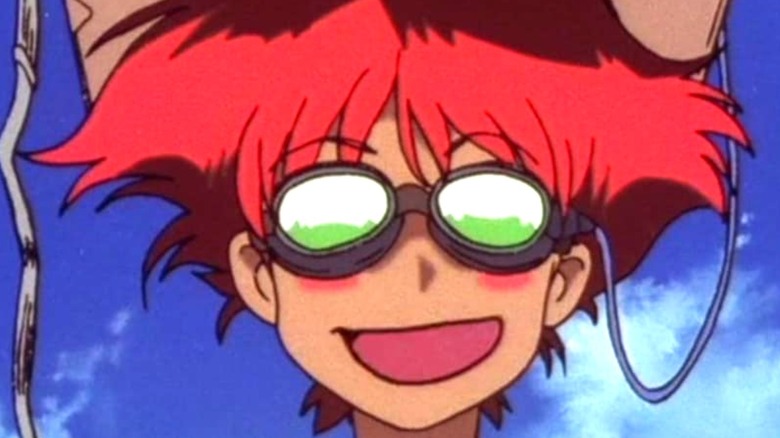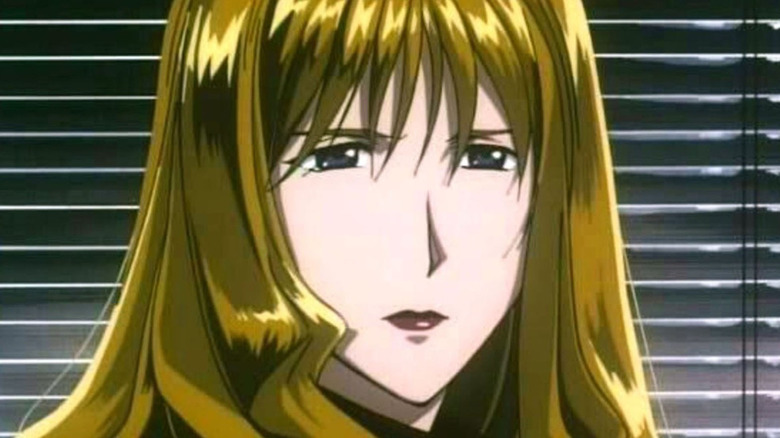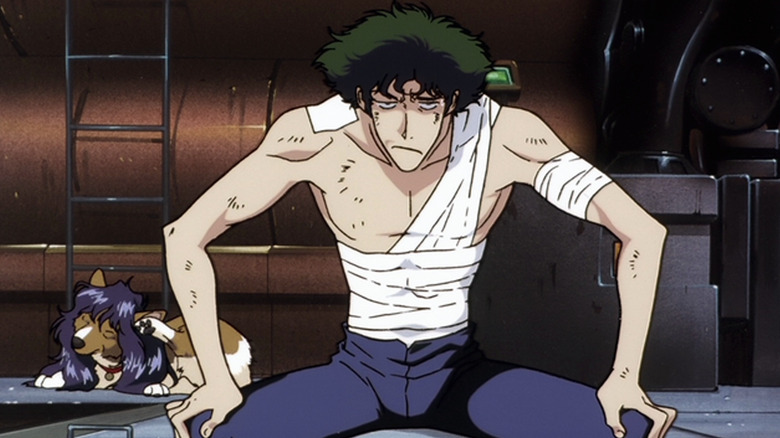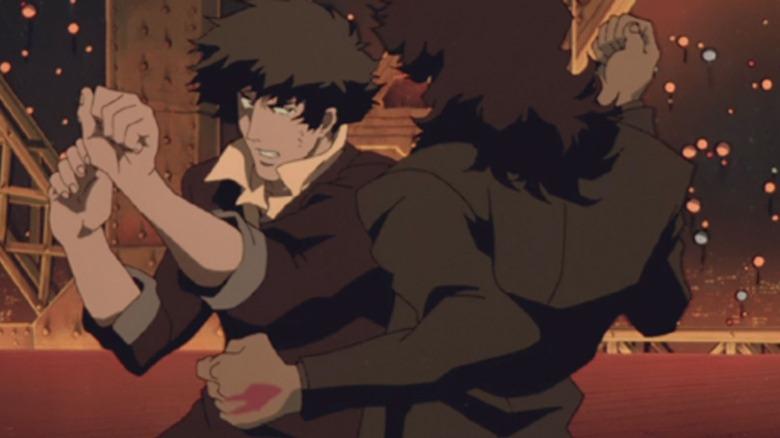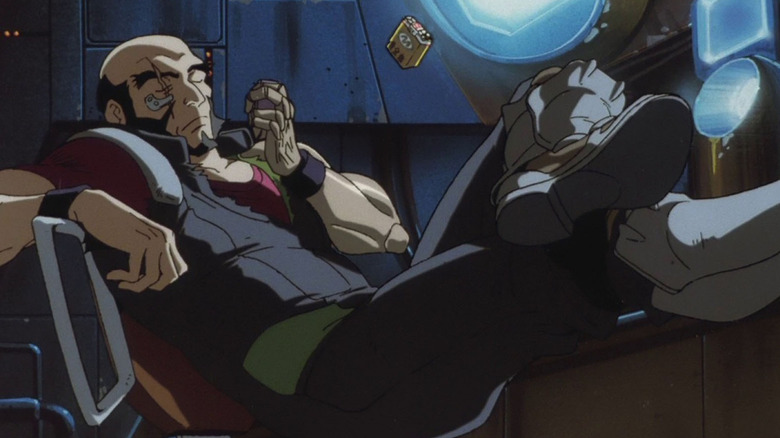Why The Ending Of Cowboy Bebop Is More Significant Than You Think
After 20-plus years, "Cowboy Bebop" remains one of the coolest animes ever produced. Every element came together – from Yoko Kanno's brilliant music to its comparative shortness, to the surprisingly well-performed English dub – to seal its legacy. "Cowboy Bebop"'s brevity, in particular, stands out among the endless iterations of "Naruto," "One Piece," and "InuYasha." The show is only 26 episodes and a movie long, and yet each episode is packed with so much plot and philosophizing that it can sometimes be a little hard to parse.
"Cowboy Bebop" tells the story of Spike Spiegel, as he drifts from planet to planet in search of bounties. He lives aboard the Bebop, a ship belonging to ex-cop Jet Black. Along for the ride are the amnesiac gambler Faye Valentine, the child hacker Ed, and the data dog Ein. These characters drift in and out of each other's lives, and the final episodes of the show depict how Spike bids adieu to each one before succumbing to his inevitable fate.
Spike's death dance
Spike became a bounty hunter after leaving his crime family, known as the Red Dragon Crime Syndicate. Spike left the Syndicate because he'd fallen in love with his partner Vicious' girlfriend, Julia. Leaving the crime family was punishable by death, and Spike got into a gunfight that almost killed him. Knowing Spike was really alive, Vicious told Julia she'd have to kill Spike, or he'd kill them both. Rather than kill the man she loved, Julia went into hiding. Ever since getting jumped out of his gang and being abandoned by Julia, Spike hasn't really been sure whether he was alive or dead, awake or asleep.
When Vicious overthrows the Syndicate's leadership, things escalate quickly for Spike. Syndicate members start coming after him, as well as looking for Julia. Julia is killed in a shootout, and her last words are "It's all a dream," confirming that she had been feeling the same existential ennui since leaving Spike. It becomes necessary to finally face Vicious. Both men believe that they are the only ones who can kill the other. After a climactic battle at the oddly conspicuous crime headquarters, Vicious is dead. Spike looks to be dying. Dead or alive, awake or asleep? In space, we see a star go out, seeming to confirm that Spike has finally gotten his answer.
The end had been planned from the beginning
"Cowboy Bebop" creator Shinichirō Watanabe had always planned on the show ending with Spike and Vicious fatally confronting each other. "Even before I made the first episode, I already had the ending in mind," he told The Daily Texan in 2006. "Even though I had the ending in mind by myself, I was opposed by my staff. They were upset because they were saying that we wouldn't be able to make a continuation." Despite staff (and fan) complaints, Watanabe stuck by his guns and made "Cowboy Bebop" an entirely self-contained story.
That being said, we never really find out if Spike really gets killed by the Syndicate. Watanabe intentionally kept the ending somewhat vague and mysterious, "Don't also forget that in the last scene of the series, Spike could be sleeping," he reminded an IGN reporter in 2017. Watanabe knew how he wanted "Cowboy Bebop" to end, with lots of ambiguity thrown in for fun. An ending where death isn't confirmed (but seems impossible to evade) has a long history in film. Fans call them "Bolivian Army Endings," in honor of how "Butch Cassidy and the Sundance Kid" ends with the two almost certainly getting gunned down by the Bolivian army (via TV Tropes).
Does the movie change anything?
After the show wrapped, a "Cowboy Bebop" movie was commissioned. But it doesn't continue the story of the show so much as insert another self-contained story inside it. "Cowboy Bebop: The Movie" takes place between episodes 22 and 23 of the series, shortly before the crew parts ways, according to an archived web page about the film. The film helps build on the themes present in the finale: the nature of reality, the surreality of violence, and never being able to fully escape one's past. The film's antagonist, Vincent, mirrors Spike in that he can't tell the difference between dreams and reality. He doesn't take it as well as Spike, however. Where Spike just sorta slouches through life, Vincent decides to bring his madness to everyone else.
The movie also brings back recurring Native American stereotype/shaman Laughing Bull. Spike visits Laughing Bull in the show's first episode. He shows up again in the "Jupiter Jazz" two-parter, which fills in some backstory with Vicious and the Titan War. In session 1, Spike tells the man that he'd been killed once by a woman, referring to the unpleasantness with Julia and the Syndicate. In the movie, Laughing Bull helps Spike come to terms with his impending mortality, telling him "there is nothing to fear." He says something similar to Jet in the finale, but Jet's not in the mood to hear it.
A lone space cowboy
At that 2017 IGN panel, Watanabe seemed to indicate that, if Spike is indeed dead, Jet will probably be living alone on the Bebop. "I guess you could say I don't think they'd get along very well," he said. "Cowboy Bebop" starts with just Spike and Jet on the ship, and it ends in much the same way. In the episode before the two-part finale, Ed and Ein leave the Bebop, seemingly to search for Ed's cartographer father. Faye also seems to leave the Bebop for good, tracking down the place her home used to be. Before Faye was frozen, she lived a charmed existence on earth. After, her home is only meteor dust.
Faye is brought back to the Bebop by a chance encounter with Julia. She returns to give Spike the message that will eventually lead to his maybe-death. With Ed, Spike, and Ein gone, Watanabe doesn't have much hope that Faye and Jet would stay partners. But that doesn't mean they'd be alone forever. In the metatextual, "next time on 'Cowboy Bebop'" section, Jet says he really came to enjoy taking care of Ein. Maybe he'll get another corgi, to keep him company.
